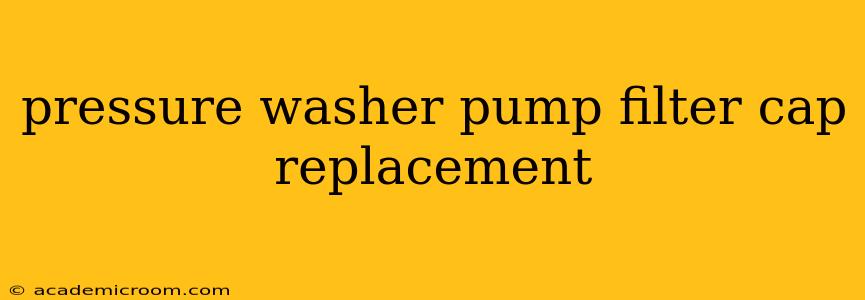Maintaining your pressure washer is crucial for its longevity and efficient performance. One often-overlooked component is the pump filter cap. This seemingly small part plays a vital role in protecting your pressure washer's pump from damage caused by debris and contaminants. This guide will walk you through everything you need to know about pressure washer pump filter cap replacement, from understanding its importance to completing the process successfully.
Why is the Pump Filter Cap Important?
The pump filter cap houses a fine mesh filter that prevents dirt, grit, sand, and other debris from entering your pressure washer's pump. These contaminants can cause significant damage, including:
- Premature wear and tear: Abrasive particles can scratch and wear down internal pump components, shortening its lifespan.
- Reduced performance: Clogged filters restrict water flow, leading to a significant decrease in pressure and cleaning power.
- Pump failure: In severe cases, debris can cause complete pump failure, requiring costly repairs or replacement.
Regular inspection and replacement of the pump filter cap are essential preventative maintenance steps to avoid these problems.
How Often Should I Replace My Pressure Washer Pump Filter Cap?
There's no single answer to how often you should replace your pressure washer pump filter cap. The frequency depends on several factors:
- Frequency of use: The more you use your pressure washer, the more likely it is that debris will accumulate in the filter.
- Water source: If you're using a water source with a high sediment content, you'll need to replace the filter more often.
- Type of cleaning: Cleaning heavily soiled surfaces will introduce more debris into the system.
As a general guideline: Inspect your filter after every few uses. If you notice significant dirt accumulation or a reduction in pressure, it's time for a replacement. A good rule of thumb is to replace the filter at least once a year, or more frequently if needed.
How to Replace a Pressure Washer Pump Filter Cap: A Step-by-Step Guide
The process of replacing a pressure washer pump filter cap varies slightly depending on the make and model of your pressure washer. However, the general steps are similar:
-
Safety First: Always disconnect the pressure washer from the power source before beginning any maintenance. Allow sufficient time for the pump to cool down.
-
Locate the Filter Cap: The filter cap is usually located on the pump's inlet side, where the water enters. It may be clearly marked or easily identifiable by its threaded connection.
-
Remove the Old Filter Cap: Use a wrench or pliers (the appropriate size will depend on your model) to carefully unscrew the filter cap. Be prepared for some water spillage.
-
Clean the Area: Clean the area around the filter cap opening to remove any debris that could fall into the pump during the replacement process.
-
Install the New Filter: Carefully insert the new filter into the opening, ensuring it's properly seated.
-
Attach the New Filter Cap: Screw the new filter cap onto the opening, tightening it securely but avoiding over-tightening. Over-tightening can damage the threads.
-
Reconnect and Test: Reconnect the pressure washer to the power source and test it to ensure proper functionality and pressure.
What are common problems I might encounter replacing a pressure washer pump filter cap?
-
Stripped Threads: If the threads on the filter cap are stripped, you may need to use a thread repair kit or replace the entire pump inlet.
-
Difficulty Removing the Cap: If the cap is particularly stubborn, try using a penetrating lubricant to loosen it. Do not apply excessive force, as you could damage the pump or the cap.
-
Finding a Replacement Cap: If you're struggling to find a replacement cap for your specific model, contact the manufacturer or search online retailers specializing in pressure washer parts.
What are the different types of pressure washer pump filter caps?
Pressure washer pump filter caps are typically made from durable materials like plastic or metal and vary slightly in size and design depending on the make and model of the pressure washer. The filter element itself is usually a fine mesh screen. Some higher-end models might feature more advanced filter systems. It's crucial to always use a replacement cap that's specifically designed for your pressure washer.
By following these steps and performing regular maintenance, you can keep your pressure washer running efficiently and extend its lifespan. Remember, a small investment in preventative maintenance can save you from costly repairs down the road.
